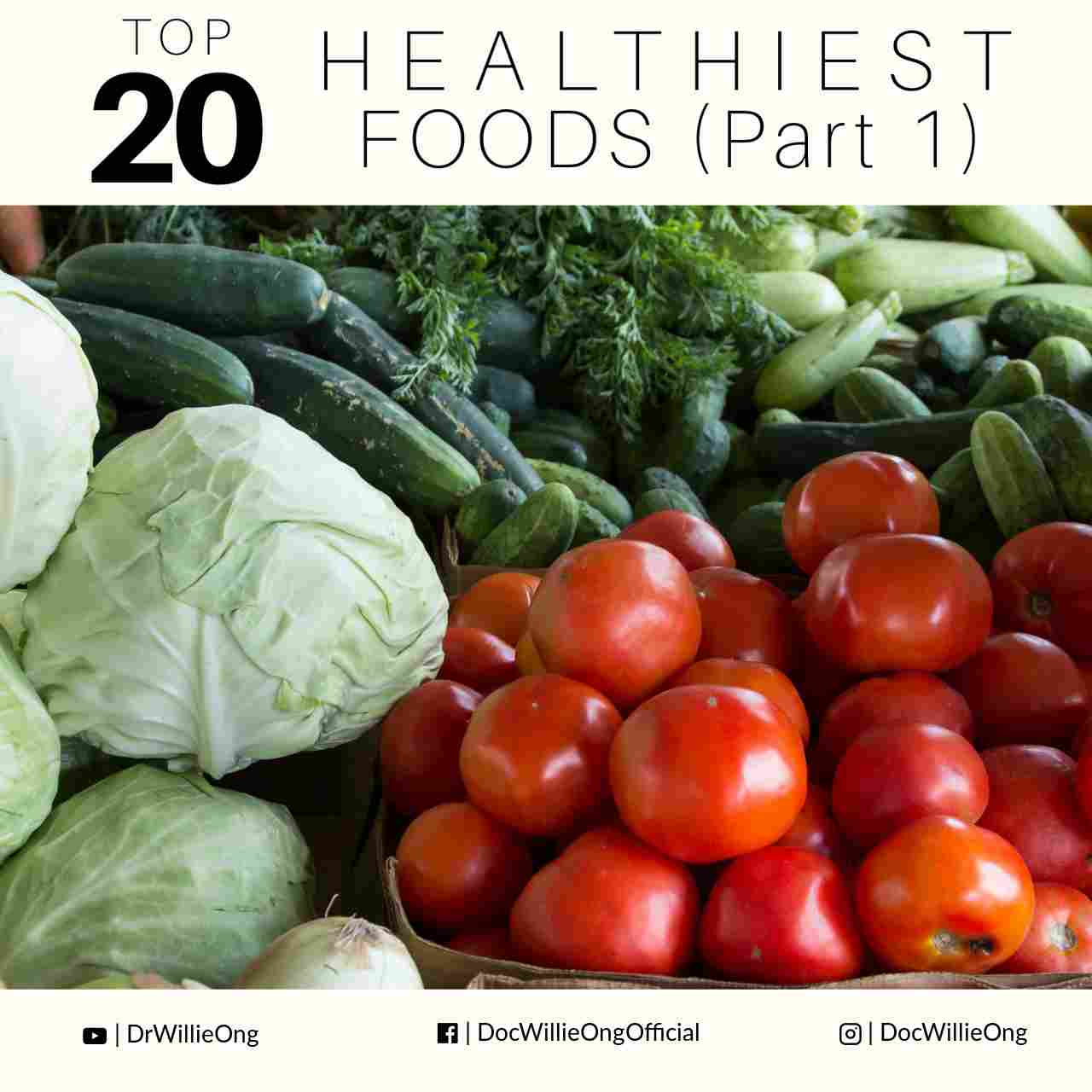By Dr Willie Ong
Q. Dear Doc, I want to eat healthy. What foods are healthy for me?
A. Your question is very appropriate. This is probably the most common question patients ask their doctor. I’ll list down the top foods experts consider to be healthy.
Here are the criteria we used in choosing our “superfoods”:
- Good source of fiber, vitamins, minerals and other nutrients.
- Rich in phytonutrients, antioxidant compounds, such as vitamins A, E and beta carotene.
- May help reduce the risk for diseases.
- Preferably low in calories, meaning you can eat a bigger portion with less calories.
- Must be affordable too.
Can’t wait to see the results? Well here it is. Coming in at number 20 as the most healthiest foods are…
Nuts
The good: Nuts are nutritional powerfoods, packed in protein, minerals and fats. Yes, they’re fatty but don’t worry, the fats found in nuts are the good fats —monounsaturated and polyunsaturated. Instead of eating junk foods reeking in unhealthy saturated fats (like potato chips and doughnuts), nuts can reduce your bad cholesterol (LDL) while raising good cholesterol (HDL). Peanuts and cashew nuts also contain vitamin E, a potent antioxidant. Almonds are expensive but they’re very nutritious.
The bad: Nuts are salty and are high in uric acid, which is bad for high blood pressure and those with gout. Also, eating too much nuts (it’s sooo addicting) can make you fat, around 150 calories per ounce. Ouch. Eat a handful not a bowl.
Coconuts including virgin coconut oil
Dr. Conrado Dayrit’s book The Truth About Coconut Oil lists many alleged health benefits for VCO, ranging from treating bacterial infection, fungal diseases such as ringworm, and even HIV-AIDS. Dr. Dayrit lists a number of case studies and smaller studies that show VCO’s beneficial effects for heart disease, diabetes and boosting ones immunity.
Coconut water, on the other hand, is good for kidney stones and cleansing the digestive tract. It’s low in carbohydrates, low in sugar and serves as an isotonic beverage, which means it’s good for replenishing your body.
Tea including black, green and oolong tea
The good: Do you want to know why Asian people (Chinese, Japanese) have less heart attacks as compared to Western people? Experts believe it’s because of their tea-drinking habit. Hot tea kills bacteria and cleanses the body. The secret is in the catechins, which acts like an artery protector, antibiotic and anti-ulcer agent. Tea also prevents dental cavities and may help you lose weight!
According to cardiologist Dr. Nelson Abelardo, studies show that green tea may prevent various cancers. In fact, green tea has the highest concentration of catechins, followed by oolong tea and the ordinary black tea (sold in supermarkets). But if you can’t afford green tea, black tea is fine too.
The bad: Tea contains caffeine which may cause heart palpitation, anxiety and high blood pressure. Don’t drink too much either.
Soy Products like tofu or taho
For semi-vegetarians like me, soy products are great substitutes for animal meat. Soy beans are high in protein, containing the essential amino acids. Soy beans are also rich in calcium, iron, zinc, magnesium, B vitamins, omega-3 fatty acids and fiber. Hence, they’re good for our heart and bones. Soy also contains genistein, a weak estrogen-like substance, which may prevent prostate and breast cancer.
Wheat in wheat bread and cereals
Some breads, cereals and muffins contain whole wheat, which can help regulate bowel movement and prevent colon cancer. Studies show that whole wheat products help control weight, prevent type-2 diabetes, and reduce cholesterol levels. Wheat may also accelerate the metabolism of estrogen and may prevent breast cancer. So next time you buy bread and cereals, look for the key words “whole wheat” and “whole grains” in the package.
Sweet potatoes (kamote)
Sweet potatoesare excellent sources of starch and contain huge amounts of carotenoids. It’s deep yellow-orange color means that they’re high in the antioxidant, beta carotene. Sweet potatoes are superb sources of fiber, vitamins B6, C and E, folate and potassium. It is these and other phytochemicals that make sweet potatoes a potent anti-cancer food.
And like all vegetables, they’re fat-free and low in calories. One small sweet potato has just 54 calories. And hear this, sweet potatoes may reduce your risk for lung cancer, especially good news to the millions of smokers and ex-smokers out there. Cooking wise, it’s best to eat them boiled, mashed or baked. Sweet potato, anyone?
Oats as in oatmeal
Take a couple of bowls of oat bran or oatmeal a day, and cut down your cholesterol levels by 10%. Oats contain beta-glucan, a spongy, soluble fiber that sucks cholesterol in the intestines and throws them out of the body. Studies suggest that oats may lower blood pressure in hypertensive patients.
Moreover, oats are one of the few grains that contain the anti-oxidant tocotrienols, a vitamin E-like substance. And the dietary fiber in oats makes you feel full faster, so it can help you control your weight. Just watch out for gassiness and bloating from too much oats.
Ginger
For centuries, ginger has been used in Asia to treat nausea, vomiting, cough, colds, headache, stomach ache and arthritis. Clinical studies show that ginger is as effective as drugs (like Dramamine) to prevent motion sickness and nausea.
Ginger contains 1-4% volatile oils. Its pungent odor comes from gingerols and shogaols, which are likely responsible for its anti-nausea and anti-vomiting effects. Ginger also acts as an antibiotic, killing bacteria in the test tube, and may have anti-cancer activity. As a first aid, try warm salabat with honey for nausea. It works.
Beans (including monggo beans)
Beans, including monggo beans, red beans and black beans, are inexpensive sources of soluble fiber, iron, folic acid, magnesium, phosphorus, potassium and thiamine. They’re also the poor man’s alternative source of protein. And to top it all, they’re low-fat, low-salt and have zero cholesterol. A half cup of cooked beans daily can reduce cholesterol, and thus are good for diabetics.
Beans contain phytonutrients that may help prevent heart disease and cancer. It also contains protease inhibitors, which help prevent the development of cancer cells. Strict vegetarians will also benefit from the large amounts of folic acid in beans, which can prevent birth defects and anemia. Not yet convinced? Beans are nutritious, delicious, easy to cook and affordable too! Just avoid them in patients with gout or high uric acid levels.
Bitter gourd (ampalaya)
Ok, I admit I’m biased. Our family members are bitter gourd lovers, especially beef with ampalaya. It’s an acquired taste since childhood. But when I heard that the lowly ampalaya has recently been added to the Department of Health’s ten approved medicinal plants, I can’t help but rejoice for my favorite vegetable.
Ampalaya (Momordica charantia) can be used to treat mild diabetes mellitus. Emphasis on mild. Ampalaya contains a hypoglycemic polypeptide, a plant insulin, responsible for its blood sugar lowering effects. Others suggest it can help in detoxification and boosting one’s immune system.
Warning: Diabetes experts strongly advise their patients to continue their regular medications and just use ampalaya as a supplement. In serious cases of diabetes, you really need your maintenance medicines.
Ok that’s our initial list of healthiest foods. Tune in next time as we conclude the countdown of the top 20 healthiest foods. In the meantime, make sure you and your loved ones are enjoying the benefits of these miracle foods. Happy eating!



